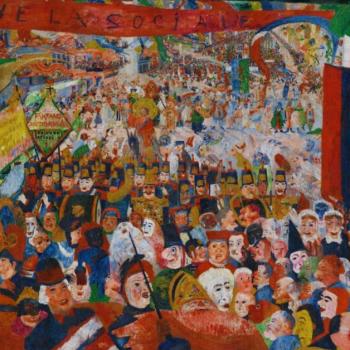
Lent. The beginning of Jesus’ dance with the Devil, “the Tempter,” out in the wilderness. A high holy day leading into a high holy season. Bearing the mark of ashes, remembering the solemn promise of dust to dust. Sacrificing as Jesus did while he was led into the desert for 40 days and 40 nights. Right?
I haven’t fasted for spiritual reasons since my teens. When I would fast it would be a particular food like chocolate, sometimes TV, or ‘secular’ music. I love music, and I always found that one the most difficult. Fasting was always a distraction as opposed to the other way around. I also have certain feelings about that sort of sacrifice and depriving oneself of everyday pleasures for spiritual gain. To be honest, I don’t feel favorable about it.
A lot of good years were spent sacrificing on levels I thought I had to, felt compelled by, or, perhaps more accurately, felt shamed into. In the end it was for no reason at all.
Also, life is short. As intelligent adults, if we make a choice for something to be or not be in our lives, whether it be chocolate, music, or otherwise, it is because it is good and right for it to be there. We make choices of our own agency and of sound mind.
Lent feels like a weird time to fast. As we contemplate death, memento mori, it doesn’t feel like an optimal time to place restrictions on how we do and engage life for 40 days.
Lent obviously has a long history and there are many things to say about it. However, the focus here will be the interaction between Jesus and the Devil out in the wilderness during those 40 days.
If you come to my home you will find a 19th century lithograph in black and white depicting this scene. The imagery is beautiful and powerful. The mythical and personified Devil, scheming and cunning in his countenance, flying off with a calm, composed, and serene Jesus in his arms.
The narrative is quite mystifying and there are a several dimensions in which this can be read and interpreted.
The first is the basic reading that Christ was tempted but overcame the Devil and in doing so has invited us to emulate this same behavior, i.e., serve God, resist the Devil, etc.
A deeper look into this narrative might take into consideration its theological backdrop and the eschatological expectation of the kingdom of God. There is also the symbolism of the 40 days and nights. It connects us to several stories that have come before this one in biblical history, that would have been fresh in the Jewish imagination of its readers. That little number, 40, produces imagery that is so rich with context, sociological and theological heritage, ancestry, and hope. I also find it particularly striking that the gospel writers use the attribute of ‘tempter’ to refer to the Devil. As this will be the central theme of this narrative.
The number 40 harkens back to the wanderings of the Israelites in the wilderness for 40 years because they couldn’t quite get it right. They were being called into the new kingdom of God, but their own missing of the mark kept them wandering for 40 years for what was only an eleven day journey.
When God destroys the earth in the story of Noah and the flood we see it rains for 40 days and 40 nights as, again, the result of human sin. We know that Moses lived in Midian for 40 years, tending flocks in the desert, after killing the Egyptian. He later spent 40 days on the mountain top while we know what was happening below.
The theological value of the number 40 would not have been lost on any reader.
Generation after generation called to lead the world by way of the kingdom of God, the one they should have been inaugurating, were thwarted again and again by their wrong doings. Here we have Jesus surviving each one of the Devil’s ‘fiery darts’ meant to derail the true mission of God, which is the kingdom of God. We will finally see, in Jesus, what Deuteronomy 30 speaks of.
This is a typical reading from a New Testament perspective and a good one at that! It is quite exciting and one that New Testament scholar N.T. Wright has had a lot to say about and for good reason.
But, what are we really seeing here? What is Jesus really being tempted unto? Is there more to the story if we go even deeper?
What we see happening here is what late Israeli Professor and Second Temple Period scholar David Flusser says is the “turning point in the history of evil itself…nothing comparable existed earlier in Judaism.”
We see a dialog in three parts within this narrative of Jesus’ dance with the Devil. The first two instances we see the Devil try to persuade Jesus by saying in Matthew 4, “If you are the Son of God, tell these stones to become bread.” He goes on a second time, “If you are the Son of God, then throw yourself down.” Both times the Devil tempts Jesus to be God, to be the Son of God, to be Divine. The real temptation here for Jesus is that he would bail on his humanity and be fully divine in a show of strength where there would be no doubt. But for Jesus, seemingly, the most valuable thing in this situation was his humanity, and living into the fullness of it.
Be God, Be God. Ok you don’t want to be God? Then be with me, the Tempter’s third and final proposition. He will make Jesus a God over all he sees.
Flusser also reminds us that the temptation is in the context of Jesus’ baptism. This is the key connection. The same spirit that was present with Jesus at his baptism is the same spirit that leads him out into the wilderness for 40 days. The baptism of Jesus is what allowed Jesus to resist his tempter.
What gave his humanity an impartation of resistance in order to defeat the Devil? To put evil in its place? It was his baptism into the new community.
What is this resistance? It is the resistance towards our usual paths to god, to all we have known up until this point. To the God that even the Devil himself tempts with and invites people into.
Peter Rollins has done a Lenten series for years called “Atheism for Lent.” But what if we did give up God for Lent? A particular construct of God? The one who is interested in displays of power and might, prestige and clout. This is the God the world tempts us with. This is the God religion can tempt us with. Or perhaps we resist such temptation toward Divinity.
Instead we opt for our own humanity that is held by community and transformed by our baptism into it. As we hang with both wild animals and angels, as the gospel narrative goes.
Jesus’ dance with the Devil, and our dance with big G God as we are tempted to a similar fate. Maybe a fate that those of Asbury fell prey to.
In the end, I’m not sure Jesus sacrificed in those 40 days. So maybe, I’m in good company. He held onto his humanity at all costs. Which is exactly what I intend to do.
*This is a piece I wrote for my patreon that I decided to share on patheos. I publish new content like this each week on my patreon , both written and audio for my New Thoughts tier. Click here for more: www.patreon.com/mariaffm













